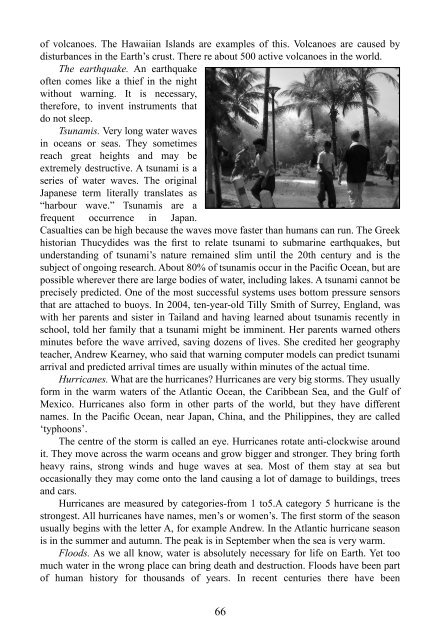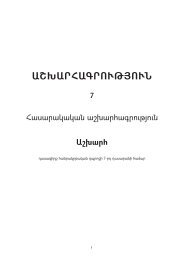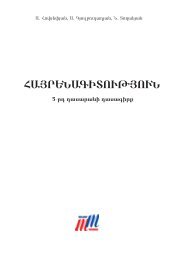Focus on Words
Focus on Words
Focus on Words
You also want an ePaper? Increase the reach of your titles
YUMPU automatically turns print PDFs into web optimized ePapers that Google loves.
of volcanoes. The Hawaiian Islands are examples of this. Volcanoes are caused by<br />
disturbances in the Earth’s crust. There re about 500 active volcanoes in the world.<br />
The earthquake. An earthquake<br />
often comes like a thief in the night<br />
without warning. It is necessary,<br />
therefore, to invent instruments that<br />
do not sleep.<br />
Tsunamis. Very l<strong>on</strong>g water waves<br />
in oceans or seas. They sometimes<br />
reach great heights and may be<br />
extremely destructive. A tsunami is a<br />
series of water waves. The original<br />
Japanese term literally translates as<br />
“harbour wave.” Tsunamis are a<br />
frequent occurrence in Japan.<br />
Casualties can be high because the waves move faster than humans can run. The Greek<br />
historian Thucydides was the first to relate tsunami to submarine earthquakes, but<br />
understanding of tsunami’s nature remained slim until the 20th century and is the<br />
subject of <strong>on</strong>going research. About 80% of tsunamis occur in the Pacific Ocean, but are<br />
possible wherever there are large bodies of water, including lakes. A tsunami cannot be<br />
precisely predicted. One of the most successful systems uses bottom pressure sensors<br />
that are attached to buoys. In 2004, ten-year-old Tilly Smith of Surrey, England, was<br />
with her parents and sister in Tailand and having learned about tsunamis recently in<br />
school, told her family that a tsunami might be imminent. Her parents warned others<br />
minutes before the wave arrived, saving dozens of lives. She credited her geography<br />
teacher, Andrew Kearney, who said that warning computer models can predict tsunami<br />
arrival and predicted arrival times are usually within minutes of the actual time.<br />
Hurricanes. What are the hurricanes? Hurricanes are very big storms. They usually<br />
form in the warm waters of the Atlantic Ocean, the Caribbean Sea, and the Gulf of<br />
Mexico. Hurricanes also form in other parts of the world, but they have different<br />
names. In the Pacific Ocean, near Japan, China, and the Philippines, they are called<br />
‘typho<strong>on</strong>s’.<br />
The centre of the storm is called an eye. Hurricanes rotate anti-clockwise around<br />
it. They move across the warm oceans and grow bigger and str<strong>on</strong>ger. They bring forth<br />
heavy rains, str<strong>on</strong>g winds and huge waves at sea. Most of them stay at sea but<br />
occasi<strong>on</strong>ally they may come <strong>on</strong>to the land causing a lot of damage to buildings, trees<br />
and cars.<br />
Hurricanes are measured by categories-from 1 to5.A category 5 hurricane is the<br />
str<strong>on</strong>gest. All hurricanes have names, men’s or women’s. The first storm of the seas<strong>on</strong><br />
usually begins with the letter A, for example Andrew. In the Atlantic hurricane seas<strong>on</strong><br />
is in the summer and autumn. The peak is in September when the sea is very warm.<br />
Floods. As we all know, water is absolutely necessary for life <strong>on</strong> Earth. Yet too<br />
much water in the wr<strong>on</strong>g place can bring death and destructi<strong>on</strong>. Floods have been part<br />
of human history for thousands of years. In recent centuries there have been<br />
66
















